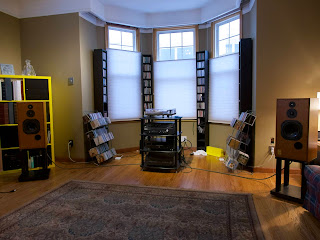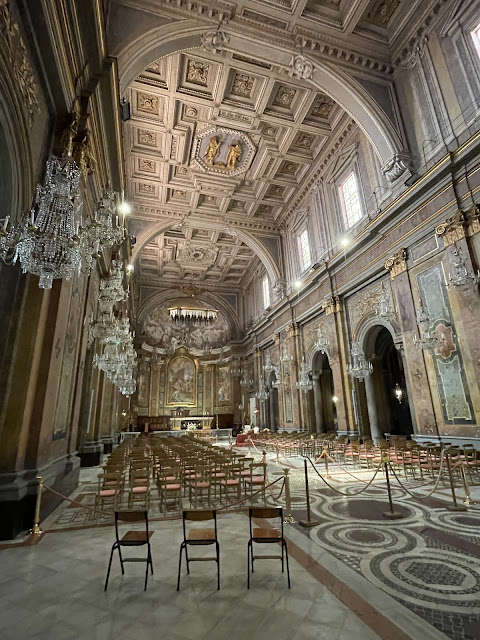A Rhythm for Prayer
Song and poetry have been part of human history for as long as we can tell. They have figured in religious practice for just as long. When I was growing up in the late 1960's and through the 1970's there was great interest in eastern religions. The Beatles might have made the idea popular. Yoga is still popular as an exercise, a way to relax and a spiritual practice. This attention to mindfulness of the body and the spirit, however, is something common to many other religious traditions.
Chant is at the forefront of Jewish religious practice. It is characteristic of the rites of Roman Catholics and of eastern Christianity, Orthodox and Catholic.
Chant is a music based upon the human breath. It is ancient. In the West, the reform and documentation of chant is linked to Pope Gregory I.
A healthy young person's resting heartbeat is 60 beats per minute. The interior rhythm of the breaths of Gregorian chant follows the rhythm of a healthy human body at rest. This is why it lends itself so much to relaxation. Even listening to chant can be a great help to relax and to clear one's mind in preparation for prayer. After some frantic days, I will sometimes put on a recording of chant to do just that. It brings me back to a more centred place from which I can give attention to God.
Often our evaluation of music is based on how much it pumps us up. Music that is not stimulating is seen as boring or depressing. It may not be the music that is depressing. It might have something to do with our own fear of facing some difficult truths about ourselves. Moving to the relaxed rhythm of chant is an opportunity to empty out the unhealthy things we are holding onto and to allow us to become open to what God wants to fill us up with.
I have collected a number of interesting recordings of chant. I suggest starting with some simple straightforward recordings of texts that even now are part of worship sometimes. The other thing to look for are albums that have a complete service recorded in a monastery with organ and bells. This helps to place the material in context and gives you a better feel for the dynamic of chant used in worship.
In the image here, you can see the traditional notation of Gregorian Chant. It looks a little different. The actual technique of the singing is also a little different.
These are some of my current collection:
Jubilate Deo, Choeurs des Moines de L'Abbaye de Melleray [Choir of the Monks of the Abbey of Melleray], Studio SM, Paris, France, 1989. Reissue of an earlier recording. Very good for becoming familiar with some of the "standards" of chant.
Canto Gregoriano, Coro do monjes del Monasterio Benedictino de Santo Domingo de Silos [Choir of the monks of the Benedictine Monastery of Santo Domingo de Silos], EMI Records, 1994. This album enjoyed quite widespread popularity at the time it was issued.
Chant byzantin, Soeur Marie Keyronz, Chorale de l'Eglise Saint-Julien-le-Pauvre, Harmonia Mundi, 2008. An exposure to Byzantine chant.
Chants de L'Eglise de Rome, Ensemble Organum directed by Marcel Peres, Harmonia Mundi, 1998, 2005. These chants predate the Gregorian reform and truly give you a visceral feel of the ancient roots of western music.
La Divine Liturgie de Saint-Jean Chrysostome, Chorale Sofia & Dimitre Rouskov, Harmonia Mundi, 1976, 1999. The Divine Liturgy of St. John Chrysostom is the most frequently celebrated form of Mass used by the various Byzantine rites. This recording is in old Slavonic.
Old Regular Baptists: Lined-out Hymnody from Southeastern Kentucky. Smithsonian Folkways, 1997. A form of singing in worship designed to be singable and clearly chantlike. The harmonies and length of musical line give a kind of drone to the music that comes from a deep place in the human heart.
Chant is at the forefront of Jewish religious practice. It is characteristic of the rites of Roman Catholics and of eastern Christianity, Orthodox and Catholic.
Chant is a music based upon the human breath. It is ancient. In the West, the reform and documentation of chant is linked to Pope Gregory I.
A healthy young person's resting heartbeat is 60 beats per minute. The interior rhythm of the breaths of Gregorian chant follows the rhythm of a healthy human body at rest. This is why it lends itself so much to relaxation. Even listening to chant can be a great help to relax and to clear one's mind in preparation for prayer. After some frantic days, I will sometimes put on a recording of chant to do just that. It brings me back to a more centred place from which I can give attention to God.
Often our evaluation of music is based on how much it pumps us up. Music that is not stimulating is seen as boring or depressing. It may not be the music that is depressing. It might have something to do with our own fear of facing some difficult truths about ourselves. Moving to the relaxed rhythm of chant is an opportunity to empty out the unhealthy things we are holding onto and to allow us to become open to what God wants to fill us up with.
I have collected a number of interesting recordings of chant. I suggest starting with some simple straightforward recordings of texts that even now are part of worship sometimes. The other thing to look for are albums that have a complete service recorded in a monastery with organ and bells. This helps to place the material in context and gives you a better feel for the dynamic of chant used in worship.
In the image here, you can see the traditional notation of Gregorian Chant. It looks a little different. The actual technique of the singing is also a little different.
These are some of my current collection:
Jubilate Deo, Choeurs des Moines de L'Abbaye de Melleray [Choir of the Monks of the Abbey of Melleray], Studio SM, Paris, France, 1989. Reissue of an earlier recording. Very good for becoming familiar with some of the "standards" of chant.
Canto Gregoriano, Coro do monjes del Monasterio Benedictino de Santo Domingo de Silos [Choir of the monks of the Benedictine Monastery of Santo Domingo de Silos], EMI Records, 1994. This album enjoyed quite widespread popularity at the time it was issued.
Chant byzantin, Soeur Marie Keyronz, Chorale de l'Eglise Saint-Julien-le-Pauvre, Harmonia Mundi, 2008. An exposure to Byzantine chant.
Chants de L'Eglise de Rome, Ensemble Organum directed by Marcel Peres, Harmonia Mundi, 1998, 2005. These chants predate the Gregorian reform and truly give you a visceral feel of the ancient roots of western music.
La Divine Liturgie de Saint-Jean Chrysostome, Chorale Sofia & Dimitre Rouskov, Harmonia Mundi, 1976, 1999. The Divine Liturgy of St. John Chrysostom is the most frequently celebrated form of Mass used by the various Byzantine rites. This recording is in old Slavonic.
Old Regular Baptists: Lined-out Hymnody from Southeastern Kentucky. Smithsonian Folkways, 1997. A form of singing in worship designed to be singable and clearly chantlike. The harmonies and length of musical line give a kind of drone to the music that comes from a deep place in the human heart.


